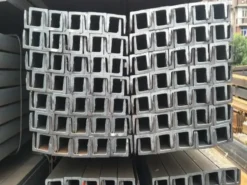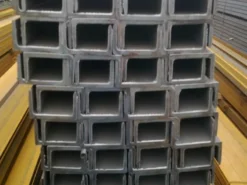I-beam, also known as steel beam (English name Universal Beam), is a long steel bar with an I-shaped cross-section.
-Introduction:
I-beams are divided into three types: ordinary I-beams, light I-beams and H-beams. The flanges of ordinary I-beams and light I-beams gradually become thinner from the root to the edge and have a certain angle. The models of ordinary I-beams and light I-beams are represented by Arabic numerals in centimeters of their waist height. The plate, flange thickness and flange width are different. The specifications are expressed in millimeters of waist height (h) x leg width (b) x waist thickness (d). For example, “General 160x88x6” means that the waist height is 160 mm and the leg width is 160 mm. It is an ordinary I-beam with a waist thickness of 88 mm and a waist thickness of 6 mm. The specifications of light industrial beams can also be expressed by model numbers, which represent the waist height in centimeters, such as general engineering 16#. If I-beams with the same waist height have several different leg widths and waist thicknesses, abc must be added to the right of the model number to distinguish them, such as General 32#a, 32#b, 32#c, etc. The specification of hot-rolled ordinary I-beam is 10-63#.
-Basic difference:
Ordinary I-beam is equivalent to the international I100 (for example, 10# channel steel is equivalent to channel steel U100); H-shaped I-beam is also called wide-flange I-beam. HW HM HN comes from the European standard, and HEB is the German standard. I-beams, among which HW\HN I-beams have been widely used and produced in my country. HEA HEB HEM can be seen on many German design drawings, but it is still difficult to buy in the domestic market. In domestic steel structure projects, if the quantity is small, steel plates of equal specifications can be welded and spliced together. If the quantity is large, it is usually considered to use HW and HN steel with equivalent mechanical properties instead.
HW I-beams are mainly used for steel core columns in reinforced bolt frame structural columns.
HM section steel height to flange width is approximately 1.33-1.75. They are mainly used as steel frame columns in steel structures and in frame structures that bear dynamic loads.
HN steel height and flange width ratio is greater than or equal to 2, mainly used for beams.
Whether I-beam is ordinary or light, due to the relatively high and narrow cross-section size, the moment of inertia of the two main axes of the cross-section is quite different. Therefore, it can generally only be used directly for loads in the plane of its web. Curved components are not suitable for use, which limits its application scope.
H-shaped steel is an efficient and economical section profile (others include cold-formed thin-walled steel, profiled steel plates, etc.). Due to their reasonable cross-sectional shape, they can make the steel more efficient and improve its load-bearing capacity. Different from the ordinary I-shaped steel, the flange of the H-shaped steel is widened, and the inner and outer surfaces are usually parallel, which makes it easier to use high-strength bolts and other components to connect. Its size series is reasonable and the models are complete, which is convenient for design and selection.
Section Height: H, Section Width: B, Web Thickness: Tw, Flange Thickness: Tf, Intersection arc radius: Rw
W=0.00785x{hd+2t(b-d)+0.615(R2-r2)}, h=Height, b=Leg length, d=Waist Thick











